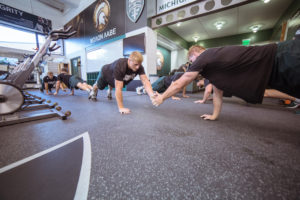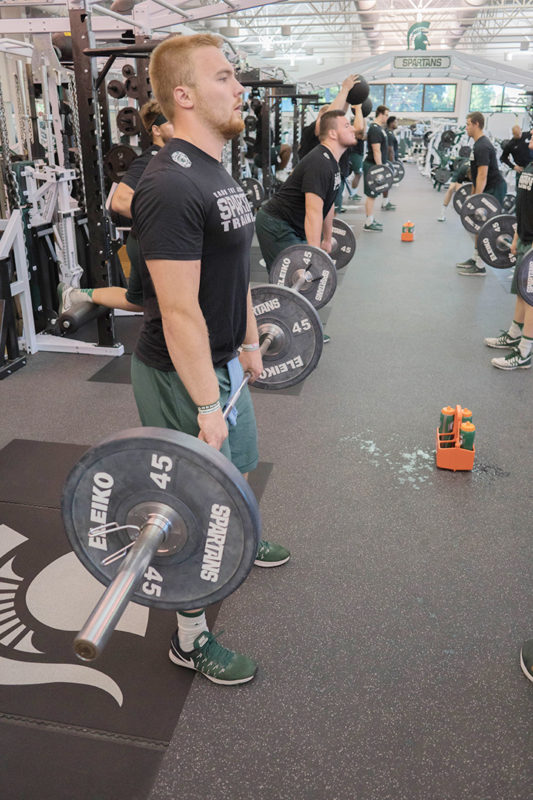Powerline: Fundamentals for a successful strength program
We often tend to get overwhelmed with the wealth of information being hurled at us at warp speed. Certainly, the day-to-day operation of a strength training program presents an abundance of challenges and an occasional brush fire.
Think about it: If you combine the elements of defining a safe, productive training philosophy, working within the confines of your educational background, facility resources, available equipment and time restraints, there’s certainly no dearth of possible complications that can surface. Unfortunately, the result of this conundrum is a woeful departure from the fundamentals that keep the system running smoothly.

The fundamentals are the basic, yet very important aspects of running a fine-tuned strength program. Let’s take a closer look at several of the areas that can run amiss if there are no checks and balances in place, and some suggestions for keeping the fundamentals on-point.
Training philosophy
Play to your strengths, but continue to learn. We have a tendency to train others the way we were trained — at least initially. As we grow and learn, it becomes an ongoing search for new ideas, cutting-edge concepts, and off-the-beaten path avenues to add value and a brand to our programs.
Whether you have an advanced degree in an exercise science-related area, or possess the minimal competencies in the field, you must constantly work to expand your knowledge base. I am on record for my beliefs on the importance of the appropriate educational tract and certification for those who train athletes at every level, and I stand by those convictions. Certification by an accredited organization is mandatory for strength coaches at the Division 1 level. It’s my hope that we soon see the day where all state high school associations require at least one exercise science (or related curriculum) educated and certified strength coach in every high school.
Regardless of one’s background in the field, it’s vital to clinic with as many professionals in the offseason as possible. Attending seminars, scheduling shadowing and one-on-one meetings are imperative for growth and development. These activities should be mandated, at the very least, for CEU requirements.
Learn every aspect of your chosen strength and conditioning format. Too often we see strength training programs haphazardly executed with minimal instruction, lack of needed feedback and poor overall supervision.
Remember, it’s crucial that you and your staff coach the chosen design with the same attention to detail and enthusiasm that’s given to the other aspects of the sport. It really doesn’t matter which “camp” you’re in; there are a lot of safe, sound, productive approaches. Here’s what matters: Believe in what you’re doing and become as well-versed as possible in it. Your confidence will be transparent to the athletes, and that will breed their trust in what you’re teaching. Send the right message by knowing your system inside-out.
Bulk-up the toolbox
It wasn’t that long ago when the basic choices for strength training were either free weights or machines. Today, those lines are not so clearly defined. Just take a look at the next equipment catalogue that all coaches receive with regularity, and that point is clearly illustrated.
 Pieces that have been labeled “functional” inundate much of the training literature, and many provide unique, productive options. And while machines with either cable/pulley or cam/chain designs with guide rods and selectorized weight stacks were once the norm, there’s a newer generation of pneumatic, computerized modalities. Certain “free motion” pieces are unencumbered by strict guiding mechanisms to give more of a “free-weight feel.” And, of course, there are numerous companies that produce “leverage” plate-loading machines that offer variable resistance through intricately designed linkage systems.
Pieces that have been labeled “functional” inundate much of the training literature, and many provide unique, productive options. And while machines with either cable/pulley or cam/chain designs with guide rods and selectorized weight stacks were once the norm, there’s a newer generation of pneumatic, computerized modalities. Certain “free motion” pieces are unencumbered by strict guiding mechanisms to give more of a “free-weight feel.” And, of course, there are numerous companies that produce “leverage” plate-loading machines that offer variable resistance through intricately designed linkage systems.
Today’s technology also offers myriad metric trackers for speed, power and workload that can offer instant feedback on these and various technique related values. These systems can be attached to lifting bars or the racks themselves. However, due to their expense, they are not a viable option for most high school programs.
I suggest that coaches keep an open mind with regard to equipment purchases. Finances are obviously the critical component, and getting the most bang for your buck on top-tier items is a must, but keep your eyes wide open on the auxiliary pieces. Remember that the muscular system responds favorably and adapts accordingly to properly applied, progressive overload, regardless of the source. If you shackle yourself to a narrow viewpoint, you deny athletes in your program a well-rounded experience that offers relief from the tedium with variety.
Here at Michigan State University, we consolidate a divergent array of modalities from the free weight, machine, functional training and other categories to extract the very best qualities each has to offer.
Improve raw material
However you look at it, our primary job as strength coaches is to introduce a training system that has a positive effect on body composition and initiates adaptations in the nervous system. Enhancing muscle growth — within the genetic capabilities of each individual athlete — exponentially heightens strength and power, thus enabling greater efficiency in the execution of athletic skills.
The groundwork for these improvements in the body’s raw material are initiated through the increases in actin and myosin (the tension generating units of muscle tissue), which are major constituents in force and power production. Strength training is a catalyst for the proliferation of actin and myosin, while concurrently magnifying the stability of tendons, ligaments and other cellular variants of connective tissue.
Running parallel with these histological upgrades are the neural adaptations that are key components in both strength and lifting skill improvements, especially in the early training phase. As athletes continue to train, they become more neurologically efficient. Hence, inhibitory messages — those that provide a safeguard in the beginning stages of training — are gradually abated. Continued progress results in a better mastery of lifting skills and a higher proficiency in muscle fiber recruitment. Gradual stimulation of the musculature with progressively higher workloads reduces inhibitory impulses picked-up by sensory receptors that monitor changes in muscle length. The result: An improved economy of muscle fiber firing and greater power output.
This is known as “motor unit synchronization,” and it’s a major player in the strength and power game plan. Motor unit synchronization enhances the speed with which a lifting movement or athletic skill is performed.
Have a recovery plan
Recovery from hard exercise requires some basic, important strategies. Here are several suggestions:
- Cool down gradually. Ease out of the training session with some toned-down movements such as walking, dynamic flexibility and static stretching. Stretching activities post-training may have longer-term benefits in cumulative flexibility due to the increase in internal temperature and blood flow to the working muscles.
- Replace fluids. Water supports every metabolic function and is a vital vehicle for nutrient transfer. Most athletes understand the importance of hydrating during competition, but continuing to drink liberally after a demanding workout or game is just as important. In order to introduce carbohydrates into the system, sports drinks of fruit juices also are wise choices.
- Eat promptly and properly. Try to eat something nutritious within 60 minutes of post-activity. Include at least 70 to 100 grams of carbohydrates, and 20 to 30 grams of high-quality protein.
- Sleep and overall rest. Proper rest and sleep are crucial during the 24- to 48-hour post-activity period. Not only does it allow for tissue repair and strength building, it can also aid the immune system in preventing illness and reduce a great deal of the mental stress athletes must endure. Most experts recommend seven to nine hours of sleep per night for athletes, and a little more when possible. Getting off their feet, if nothing else, and easing into a relaxation mode can do wonders for their physical recovery and mental disposition.
Litmus test for your strength program
Here are some important questions coaches need to ask to determine the efficacy of their programs:
- Is it safe? The weight room environment has enough potential for a mishap without adding questionable exercises or activities that heighten the risks. Inspect your program from the inside-out, consult with those who have more experience in the profession, and do your due diligence in thoroughly researching anything that raises concern before implementing it.
- Is it practical? Having an exotic strength training scheme that’s complicated, misunderstood or difficult to execute isn’t helping anyone. And, due to its complex nature, you stray into the unsafe zone. Strength training should be based upon scientific principles, and if it truly is, it’s not overly complicated at all. Focus on the basics; have a gradual, overload plan; coach excellent technique and effort; and control total volume/training frequency. Do all of these along with installing proper recovery strategies, and good things will happen.
- Is it productive? Are you using an evidence-based program, and getting consistent results without injuries? Then you’re probably doing something right. Stay on the learning curve, keep improving, and stay true to the fundamentals.
- Is it efficient? In the current landscape of high school and collegiate athletics, time is of the essence. Are you getting the most out of every minute at your disposal? All work and recovery intervals should be closely monitored to assure that an appropriate training tempo is maintained and that all required work is being accomplished in the given time frame.
- Is it built for the long-term? You’re not going to go far grab-bagging it with untested, fly-by-night movements and activities that you picked-up from an internet blog. Build the foundation of your program with the cornerstones of strength training, including multi-joint, multi-directional leg/hip movements, upper torso presses and pulls, body weight exercises (e.g., chins and dips), core, and neck work. Fundamentals achieve results.
Ken Mannie is the head strength and conditioning coach Michigan State University. His column, Powerline, appears regularly in Coach & Athletic Director magazine.


